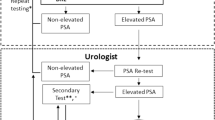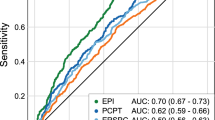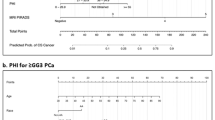Abstract
Background:
The aim of the study was to evaluate the correlation between preoperative [-2]proPSA, the Gleason Score (GS) and the risk of non-organ-confined (NOC) disease in patients undergoing radical prostatectomy (RP).
Methods:
Beckman Coulter Access immunoassay was used to study serum specimens of 381 patients enrolled in a prostate cancer (PCa) early detection program. Inclusion criteria were three or more available serum specimens over 4 years before diagnosis. The values obtained were correlated with the GSs and pathological stages of specimens obtained at RP.
Results:
[-2]proPSA levels were significantly higher in the cancer group (n=208) than in the benign group (n=173). Already 4 years before diagnosis [-2]proPSA differed significantly between PCa and benign prostate in all measured time points, however, highest prediction value was 2 and 1 years before diagnosis (P<0.001). When stratified [-2]proPSA levels according to GS of RP specimens, [-2]proPSA was highest in patients with ⩾GS8 and lowest in those with ⩽GS6.
The difference in [-2]proPSA values between GS⩾8 and GS⩽7 was highly significant (P<0.01) already 3 years before diagnosis. Investigating the correlation between extraprostatic extension and the preoperative [-2]proPSA levels we found preoperative [-2]proPSA values significantly higher in men with NOC PCa compared with organ-confined (OC) cancers.
The highest predictive value of [-2]proPSA to differ between OC and extraprostatic extension was found 3 and 2 years before RP.
Conclusions:
Patients with high [-2]proPSA levels in the years before cancer diagnosis are at a higher risk of having aggressive PCas. Thus, the [-2]proPSA should be included in the treatment decision-making for managing screen-detected PCa.
This is a preview of subscription content, access via your institution
Access options
Subscribe to this journal
Receive 4 print issues and online access
$259.00 per year
only $64.75 per issue
Buy this article
- Purchase on Springer Link
- Instant access to full article PDF
Prices may be subject to local taxes which are calculated during checkout



Similar content being viewed by others
References
Jemal A, Bray F, Center MM, Ferlay J, Ward E, Forman D . Global cancer statistics. CA Cancer J Clin 2011; 61: 69–90.
Heidenreich A, Bellmunt J, Bolla M, Joniau S, Mason M, Matveev V et al. [EAU guidelines on prostate cancer. Part I: screening, diagnosis, and treatment of clinically localised disease]. Actas Urol Esp 2011; 35: 501–514.
Nelson WG, De Marzo AM, Isaacs WB . Prostate cancer. N Engl J Med 2003; 349: 366–381.
Emiliozzi P, Longhi S, Scarpone P, Pansadoro A, DePaula F, Pansadoro V . The value of a single biopsy with 12 transperineal cores for detecting prostate cancer in patients with elevated prostate specific antigen. J Urol 2001; 166: 845–850.
Catalona WJ, Partin AW, Finlay JA, Chan DW, Rittenhouse HG, Wolfert RL et al. Use of percentage of free prostate-specific antigen to identify men at high risk of prostate cancer when PSA levels are 2.51 to 4 ng/ml and digital rectal examination is not suspicious for prostate cancer: an alternative model. Urology 1999; 54: 220–224.
Roehl KA, Antenor JA, Catalona WJ . Serial biopsy results in prostate cancer screening study. J Urol 2002; 167: 2435–2439.
Strope SA, Andriole GL . Prostate cancer screening: current status and future perspectives. Nat Rev Urol 2010; 7: 487–493.
Hori S, Blanchet JS, McLoughlin J . From prostate-specific antigen (PSA) to precursor PSA (proPSA) isoforms: a review of the emerging role of proPSAs in the detection and management of early prostate cancer. BJU Int 2012; 112: 717–728.
Ward AM, Catto JW, Hamdy FC . Prostate specific antigen: biology, biochemistry and available commercial assays. Ann Clin Biochem 2001; 38 (Pt 6): 633–651.
Djavan B . Validity and legacy of prostate-specific antigen (PSA) and PSA-based parameters and isoforms in the new millennium. Eur Urol 2010; 57: 928–929.
Chan TY, Mikolajczyk SD, Lecksell K, Shue MJ, Rittenhouse HG, Partin AW et al. Immunohistochemical staining of prostate cancer with monoclonal antibodies to the precursor of prostate-specific antigen. Urology 2003; 62: 177–181.
Catalona WJ, Bartsch G, Rittenhouse HG, Evans CL, Linton HJ, Amirkhan A et al. Serum pro prostate specific antigen improves cancer detection compared to free and complexed prostate specific antigen in men with prostate specific antigen 2 to 4 ng/ml. J Urol 2003; 170 (6 Pt 1): 2181–2185.
Catalona WJ, Bartsch G, Rittenhouse HG, Evans CL, Linton HJ, Horninger W et al. Serum pro-prostate specific antigen preferentially detects aggressive prostate cancers in men with 2 to 4 ng/ml prostate specific antigen. J Urol 2004; 171 (6 Pt 1): 2239–2244.
Mikolajczyk SD, Millar LS, Marker KM, Wang TJ, Rittenhouse HG, Marks LS et al. Seminal plasma contains "BPSA," a molecular form of prostate-specific antigen that is associated with benign prostatic hyperplasia. Prostate 2000; 45: 271–276.
Sokoll LJ, Chan DW, Mikolajczyk SD, Rittenhouse HG, Evans CL, Linton HJ et al. Proenzyme psa for the early detection of prostate cancer in the 2.5-4.0 ng/ml total psa range: preliminary analysis. Urology 2003; 61: 274–276.
Sokoll LJ, Sanda MG, Feng Z, Kagan J, Mizrahi IA, Broyles DL et al. A prospective, multicenter, National Cancer Institute Early Detection Research Network study of [-2]proPSA: improving prostate cancer detection and correlating with cancer aggressiveness. Cancer Epidemiol Biomarkers Prev 2010; 19: 1193–1200.
Jansen FH, van Schaik RH, Kurstjens J, Horninger W, Klocker H, Bektic J et al. Prostate-specific antigen (PSA) isoform p2PSA in combination with total PSA and free PSA improves diagnostic accuracy in prostate cancer detection. Eur Urol 2010; 57: 921–927.
Loeb S, Sokoll LJ, Broyles DL, Bangma CH, van Schaik RH, Klee GG et al. Prospective, Multi-Center Evaluation of the Beckman Coulter Prostate Health Index Using WHO Calibration. J Urol 2012; 189: 867–870.
Oesterling JE, Jacobsen SJ, Chute CG, Guess HA, Girman CJ, Panser LA et al. Serum prostate-specific antigen in a community-based population of healthy men. Establishment of age-specific reference ranges. JAMA 1993; 270: 860–864.
Reissigl A, Horninger W, Fink K, Klocker H, Bartsch G . Prostate carcinoma screening in the county of Tyrol, Austria: experience and results. Cancer 1997; 80: 1818–1829.
Bartsch G, Horninger W, Klocker H, Pelzer A, Bektic J, Oberaigner W et al. Tyrol Prostate Cancer Demonstration Project: early detection, treatment, outcome, incidence and mortality. BJU Int 2008; 101: 809–816.
Laffin RJ, Chan DW, Tanasijevic MJ, Fischer GA, Markus W, Miller J et al. Hybritech total and free prostate-specific antigen assays developed for the Beckman Coulter access automated chemiluminescent immunoassay system: a multicenter evaluation of analytical performance. Clin Chem 2001; 47: 129–132.
Mikolajczyk SD, Marker KM, Millar LS, Kumar A, Saedi MS, Payne JK et al. A truncated precursor form of prostate-specific antigen is a more specific serum marker of prostate cancer. Cancer Res 2001; 61: 6958–6963.
Finlay JA, Day JR, Evans CL, Carlson R, Kuus-Reichel K, Millar LS et al. Development of a dual monoclonal antibody immunoassay for total human kallikrein 2. Clin Chem 2001; 47: 1218–1224.
Zhu X, Albertsen PC, Andriole GL, Roobol MJ, Schroder FH, Vickers AJ . Risk-based prostate cancer screening. Eur Urol 2012; 61: 652–661.
Stephan C, Jung K, Lein M, Diamandis EP . PSA and other tissue kallikreins for prostate cancer detection. Eur J Cancer 2007; 43: 1918–1926.
Stephan C, Kahrs AM, Cammann H, Lein M, Schrader M, Deger S et al. A [-2]proPSA-based artificial neural network significantly improves differentiation between prostate cancer and benign prostatic diseases. Prostate 2009; 69: 198–207.
Lazzeri M, Haese A, de la TA, Palou RJ, McNicholas T, Lughezzani G et al. Serum isoform [-2]proPSA derivatives significantly improve prediction of prostate cancer at initial biopsy in a total PSA range of 2-10 ng/ml: a multicentric European study. Eur Urol 2013; 63: 986–994.
Prensner JR, Rubin MA, Wei JT, Chinnaiyan AM . Beyond PSA: the next generation of prostate cancer biomarkers. Sci Transl Med 2012; 4, 127rv3.
Pelzer AE, Colleselli D, Bektic J, Steiner E, Ramoner R, Mitterberger M et al. Pathological features of Gleason score 6 prostate cancers in the low and intermediate range of prostate-specific antigen level: is there a difference? BJU Int 2008; 101: 822–825.
Author information
Authors and Affiliations
Corresponding author
Ethics declarations
Competing interests
The authors declare no conflict of interest.
Additional information
Supplementary Information accompanies the paper on the Prostate Cancer and Prostatic Diseases website
Supplementary information
Rights and permissions
About this article
Cite this article
Heidegger, I., Klocker, H., Steiner, E. et al. [-2]proPSA is an early marker for prostate cancer aggressiveness. Prostate Cancer Prostatic Dis 17, 70–74 (2014). https://doi.org/10.1038/pcan.2013.50
Received:
Revised:
Accepted:
Published:
Issue Date:
DOI: https://doi.org/10.1038/pcan.2013.50
Keywords
This article is cited by
-
Preoperative %p2PSA and Prostate Health Index Predict Pathological Outcomes in Patients with Prostate Cancer Undergoing Radical Prostatectomy
Scientific Reports (2020)
-
PSA screening—a matter of debate?
memo - Magazine of European Medical Oncology (2019)
-
Clinical utility of the Prostate Health Index (phi) for biopsy decision management in a large group urology practice setting
Prostate Cancer and Prostatic Diseases (2018)
-
Clinical and Novel Biomarkers in the Management of Prostate Cancer
Current Treatment Options in Oncology (2018)
-
ProPSA and the Prostate Health Index as predictive markers for aggressiveness in low-risk prostate cancer—results from an international multicenter study
Prostate Cancer and Prostatic Diseases (2017)



